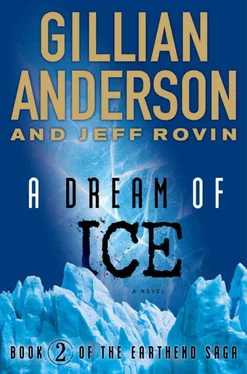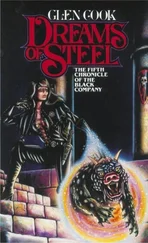“He was as sane as any of us,” Siem snapped.
“Really? You mentioned that he ran out of ice screws so he slid the rest of the way down the crevasse.”
“It was not very far.”
“Far enough that he couldn’t climb it?”
“Yes—”
“Thereby leaving himself without a way back up. He knew this, did he not?”
“He did, which is why I hammered in the screws he’ll need.”
“Did he ask you to do that?”
Siem was silent.
“Der Graaf. Did Mikel Jasso ask you if you had extra ice screws?”
After a long moment Siem answered, “No.”
“Then he was mad. Or a reckless fool. I don’t know which, and sadly, I cannot afford to care.”
“So, then, we let a mad, reckless fool die in a crevasse, because it is dangerous and inconvenient to rescue him and recover his scientific find—which, I may add, is one reason we are out here. To expand human knowledge.”
“Damn you. You’re not even a scientist! You’re maintenance!”
“That, sir, is not an argument.”
Trout waved away the rebuke. “Anyway, you know me better. We have to get the station onto grounded ice, ice that isn’t inexplicably melting, ice that isn’t subject to unpredictable seismic occurrences as our Norwegian friends have cautioned us. Now, you are wasting my—”
“We can do both,” Siem said. “We can. We must.”
“No.”
With a brusque sweeping movement, Trout made sure Siem left the module ahead of him. He also assigned the young man to assist Ivor and Dr. Bundy on all tasks, so that he couldn’t steal a Ski-Doo and try to rescue Mikel by himself.
Outside, tempers were hair-trigger and the clipped conversations were tense. It was more than just the pressure of setting up to tow the jam tart and its seven blue sisters, one by one, across almost forty miles of ice. Every person on the team felt that the outside world was filled with odd shadows that did not seem to align with the position of the sun. Over and over the workers’ eyes snapped toward things that weren’t there. No one ever took safety and security for granted here. But no one had ever feared their surroundings quite like this, either.
The weather was cooperating at least: almost no wind, and not cold enough to comment on it.
Eric Trout did the rounds, checking in by radio with each person to make sure they were a go. Then, from inside one module, he started flicking switches. First their radios died. Then the modules. Everyone felt instantly forlorn and abandoned; even Ivor, who had been singing a Scottish drinking song, stopped.
Trout clambered down and signaled to the engineer in charge of the first blue research center to be towed.
Siem, who had been working with Dr. Bundy securing the laboratory, stopped suddenly.
“Do you feel that?” he muttered to the scientist.
“What?”
“In your stomach,” Siem said. “Pressure. Waves of pressure.”
Bundy hesitated, then replied, “A little. It’s just nerves.”
“Just nerves… doing what?” Siem asked earnestly.
Bundy looked at him strangely and didn’t reply.
Several men worked with shovels around the ski tip of one strut of the blue unit until it began rising. Siem joined them, trying to give himself something to focus on besides his uneasiness. When the leg had completely retracted, they began to pack snow a meter deep beneath it. Repeating this process with the other three supports would create a new, sturdy foundation for the structure to rise on its hydraulics, allowing for its hitch frame to be attached. Then the team would attach it to a bulldozer and a truck for its long trip across the ice.
As they worked on the snow beneath each leg, Siem noticed that his discomfort increased when the jacking stopped and the team was working in silence. He also noticed that he wasn’t the only one feeling it. Several of the people paused to adjust their waistbands or rest their hands on their ribs.
Even Bundy noticed and glanced around, his goggled eyes coming to rest in Siem’s direction.
Suddenly Ivor griped, “What in the great white hell is goin’ on? I feel like I’m at a bloody rock show!”
With little wind to scatter sound, his words rang clearly over the work site. There was a chorus of agreement.
“That’s exactly it,” someone said. “I feel like I have a big sound speaker on my stomach.”
“Not a speaker,” Ivor said. “A subwoofer.”
“Yes,” Siem said. There seemed to be a very low-pitched, sub-audible frequency, something none of them had ever experienced.
The team was silent a moment, looking toward the horizons. But their world was still empty save for the modules and vehicles… and shadows that looked out of sync.
Everyone jumped when the last hydraulic leg started jacking up.
“That’s all we need,” muttered Bundy. “Mass hysteria.”
“What about the PALAOA recording?” Siem asked. “Could that be the problem?”
The Perennial Acoustic Observatory in the Antarctic Ocean was a German effort located northeast of the Troll station, under the ice and underwater. A year or so ago they had picked up a remarkably loud, very deep buzz that sounded like a droning airplane engine. “A bit like the world’s largest didgeridoo,” as one of the Australians had described it. And the Germans had confirmed that there were no ships anywhere within a thousand miles of the receiver, so to date the source was another of Antarctica’s multitude of mysteries.
“We’d actually hear it if that were it,” said Bundy.
“And we’re not underwater anyway,” Ivor said, wandering over.
“Maybe we’d better call the Norweg—” Trout started, then looked back at the dark power module. “Oh. Damn.”
“You think it could be seismic?” Siem asked.
Trout shook his head. “If it was an earthquake, we wouldn’t feel it in our guts but nowhere bloody else.”
The hydraulic leg stopped when it had fully retracted. The silence was as empty as the vista surrounding them. Everyone set their shovels to the snow. Because the air was still and crystal particles of ice did not stir, no one saw a blank space of air pucker about a hundred feet from the module. Slowly, the void sucked itself into the invisible shape of a circle. Then it blew itself out.
The team didn’t see it but they felt it in their bellies. Nearly everyone cursed and swung their hands to grip their torsos, dropping their shovels.
The air puckered again in a different spot, in the shadow of a module, collapsing on itself like a vertical sinkhole. The shadow shrank, then expanded, so this time half the team saw it and cried out. A moment later the air snapped back to normal. Amid the shouting, Bundy, the nearest, ran to the spot and stood in it, waving his arms around.
“I don’t feel a damn thing!” he called.
Then there was a horribly recognizable sound—metal, wrenching. They spun and watched as the facing wall of the nearest blue module pinched inward, as though grabbed from the inside. It continued to implode with a crunching noise until it formed the shape of a circle. Then the metal flew outward with a metallic shriek. The surrounding joints held, the wall did not detach, but it warped as it expanded, leaving it bulbous and grotesque.
Almost instantly, the air behind Siem sucked back, his shoulders with it. Trout grabbed his sleeve and pulled hard. Siem opened his mouth but couldn’t scream. Trout jerked him free just as the air blew convex, knocking Siem to his knees, then facedown. In shock, he quickly raised his head and shook the snow from his face as Trout bent protectively over him.
There was another metallic squeal. This time it was a leg of the module they’d been working on. As the air pulled back, the leg bent with it, and suddenly there was a flash of light like sustained lightning, brilliant and unyielding. As the first painful shock of the magnesium-white flare subsided, the glow seemed to possess a shape.
Читать дальше












